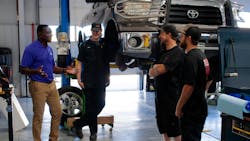According to the Chapman University Survey on American Fears, Glossophobia, commonly known as the fear of public speaking, cripples one in four Americans. While you may think ‘I run an auto repair shop, I’m not keynoting conferences’ what you don’t realize is that every interaction you have with another individual or with groups of people qualifies as a public speaking event.
As the mouthpiece of your organization. According to the 2023 Ratchet+Wrench Industry Survey Report, sponsored by AutoZone and Mobil 1, 51% of shop owners aren’t regularly meeting with their teams. If you don’t connect, you’ll struggle to provide a clear vision that rallies your team. You’ll have, in the words of Captain in “Cool Hand Luke,” “... failure to communicate.”
So, let’s remedy it.
How Great Leaders Communicate
What do Nelson Mandela, Abraham Lincoln and Martin Luther King Jr. have in common? All three were well known for listening to the voices of the people they led. Mandela developed a reputation for listening intently to the views of others before interjecting his thoughts into a situation. Lincoln was known to walk amongst the tents of the Union soldiers and hold cabinet meetings in the late hours of the night to get a complete understanding of the war. King took the reports of injustice he heard from across the South and mobilized protesters to stand against racism. The most effective leaders aren’t those who stand on their own ideas first. They’re those who keep an open mind, open door and invite the thoughts, ideas and opinions of those whom they lead. Not to be confused with hearing, listening is an active practice. It shows those whom you lead that their words hold meaning to you. As the late Stephen Covey once said, “Seek first to understand, then be understood.”
"Listening, (while) it may sound very easy, is very difficult. Sometimes when you're talking, people will tell you, ‘Yes, I'm listening.’ But you know, there are two different kinds of listening. One of them is listening to understand. The other one is listening to respond,” Dana Nkana, chief learning officer, Scott's Automotive Inc, says.
No One Walks Away Unclear
French enlightenment writer Voltaire (1694-1778) once said “Judge a man by his questions, rather than his answers.” Simply put, when leaders ask“First of all, when we're listening to employees during a conversation, we do the nonverbal—nod your head or give eye contact to show that you're really getting it; you're interested in what they're saying. Then follow up with what I define as clarifying questions: ‘Did I hear you say that every time we bring in a car, we don't give the correct information? Is that what I heard?’ You're asking that clarifying question to make sure that you're not misquoting or misinterpreting what they were saying. And then, they’re going to understand that 'OK, he's really interested; he's trying to understand what I say’,” Nkana says.
The converse also holds. There are times when the shop owner sends a memo, texts a message or speaks to the team and the message may lack clarity for some hearers. In those cases, team members need to feel comfortable and confident enough to approach the shop owner to ask clarifying questions to carry out their marching orders within the shop. Communication must be seen as a two-way flow. Speak clearly and openly and never assume clarity or leave expectations unspoken.
"We want to have that transparency in communication. If you do not have transparency in communication and give employees the ability to ask clarifying questions, it breeds what we call uncertainty. So, let's say you send out a message and it is not clear (to your team), nobody clarifies that situation to them, it leads to uncertainty where people are going to start gossiping ... and then all of a sudden the work is not going,” Nkana says.
Nonverbal Cues
According to body language expert Patti Wood, author of “Snap: Making the Most of First Impressions, Body Language, and Charisma,” people can exchange up to 10,000 nonverbal cues within a single minute of an in-person conversation. Moreover, she says what’s communicated unconsciously and nonverbally can say much more than the words that are subsequently exchanged during the conversation. For leaders, this means being cognizant of what you’re communicating when saying nothing. This includes the look on your face when you hear unfavorable news from a service advisor, the change in your posture during a disagreement with a technician, the darting of your eyes when you’re given feedback on a process that isn’t working and how you rest your hand (particularly if you cross them over your chest) when talking to a customer.
"Nonverbal is a vital portion of communication that sometimes most people don't even think about. We do a lot of training and one of the things that we do is encourage people to always pay attention to how somebody's reacting to a particular situation. There may be a situation where you’re speaking to your team in a group meeting and notice the nonverbal communication of a tech or an advisor folding their arms or leaning forward in their chair or making a face. In those situations, rather than internalize what you think the gesture may mean, it’s best to communicate directly with the person privately in a one-on-one meeting to ensure that you’re both understanding one another,” Nkana says.
Double Down on Empathy
"It is very important that we have empathy in order to really talk to other people depending on the situation. What really breaks down conversation or communication is sometimes when you talk about empathy, people always misunderstand empathy to mean sympathy. They are not the same thing,” Nkana says. “You empathize with people based on the situation. Sometimes you don't know what somebody else is going through. So, we have to bring that into the forefront when we're having a conversation and understand what is going on. When we empathize with people, we can have a smooth conversation without any breakdown or insulting.”
Want to Improve? Open Your Mouth.
If speaking isn’t your strength and you find yourself resonating with the quarter of Americans who are terrified of speaking, take a lesson from James Clear’s “Atomic Habits.” In his bestseller, he advocates for people who want to improve their skills to take baby steps. Here are Clear’s three rules for cementing a habit, as spelled out on his blog (jamesclear.com):
1. You have to start with a version of the habit that is incredibly easy for you. It must be so easy that you can’t say no to doing it and so easy that it is not difficult at all in the beginning.
2. You have to increase your habit each day but in an incredibly small way.
3. Even after increasing your habit, all repetitions must remain easy. The total habit should be broken down into easier pieces if needed.
What does this look like for a shop owner? First, it’s greeting every team member every day or asking them how they’re doing every morning. Next, it’s inching past the pleasantries and discussing how they’re doing with work and where you can help. Finally, it’s moving into doing weekly one-on-ones.
"Start talking to your team. Don't feel that you know everything as a shop owner. Go to the lowest person and start communicating. Ask, 'Hey, how does your day work? How do you talk to the customers?' You cannot sit on a pedestal and watch everything. Go to people and make them feel open to talking to you. That's where you're going to start having very good smooth conversations without any glitches in your system,” Nkana says.
Talk Tips for Techs Turned Owners
Dan Taylor, a Transformer’s Institute coach with nearly 35 years of executive management, consulting and business development, says it’s important for shop owners to master the art of communication. Given that many shop owners are former technicians, it’s all the more important for them to learn to come out of their shells and become the leaders they set out to become. Here are his tips for improving communication, as told to Chris Jones.
Get Feedback Each Time You Speak
Communication is a soft skill. Everybody thinks they're better at it than they are. We need to work on it. You've got to have feedback. Have somebody in your life giving you feedback. You've got to have internal champions on your team who are willing to say, 'Hey, you know what, I don't think you said that with enough passion because I don't think people took it seriously enough.' Every single person who receives your message is going to perceive it differently, which is a heck of a challenge, right? But you have to keep communicating. So, the communication will never end, and the feedback look will never end.
People are More Complex Than Cars; Be Patient
I know over 100 people in my leadership groups, and there's a sizable chunk of them who (became shop owners) as technicians. And in almost every one of them, their superpower is problem solvers. That's what they do, right? They solve a problem on a vehicle. They identify it, they diagnose it and they fix it. And even if it's a comeback, typically it comes back one time. Well, guess what? You can't diagnose communication; it's an ever-moving, evolving dynamic thing. If you want to communicate something, not only do you have to communicate it repetitively, but you might also have to repackage it and redeliver it over and over again. And when you think you're done communicating and repackaging it, guess what? You get to go back and do it again. And I think that's where some (shop owners) get frustrated. ‘Why can't it work like a car where I identify the problem and fix it?’ Well, people don't work that way. We're not communicating with somebody in an A-B-C step. It's a journey of infinite and ongoing dialogue and communication.
About the Author
Chris Jones
Group Editorial Director
Chris Jones is group editorial director for the Vehicle Service & Repair Group at EndeavorB2B.
A multiple-award-winning editor and journalist, and a certified project manager, he provides editorial leadership for the auto care industry's most trusted automotive repair publications—Ratchet+Wrench, Modern Tire Dealer, National Oil & Lube News, FenderBender, ABRN, Professional Distributor, PTEN, Motor Age, and Aftermarket Business World.
Subscribe to receive news and updates from any of these industry-leading brands.



